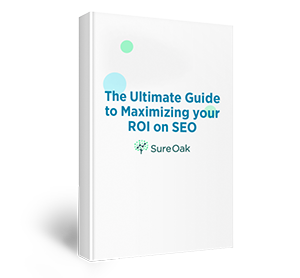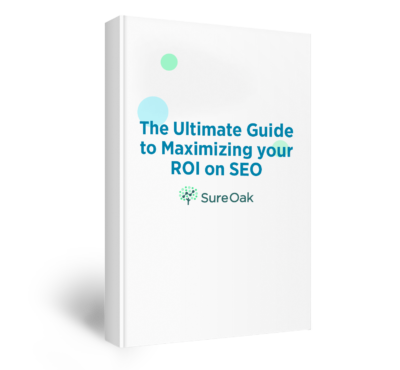Despite recent changes to Google’s ranking algorithms, backlinks remain one of the most essential SEO factors in 2024.
Google has revealed that links are one of its top 3 search ranking factors. Recent studies show that links make it easier to outrank competitors.
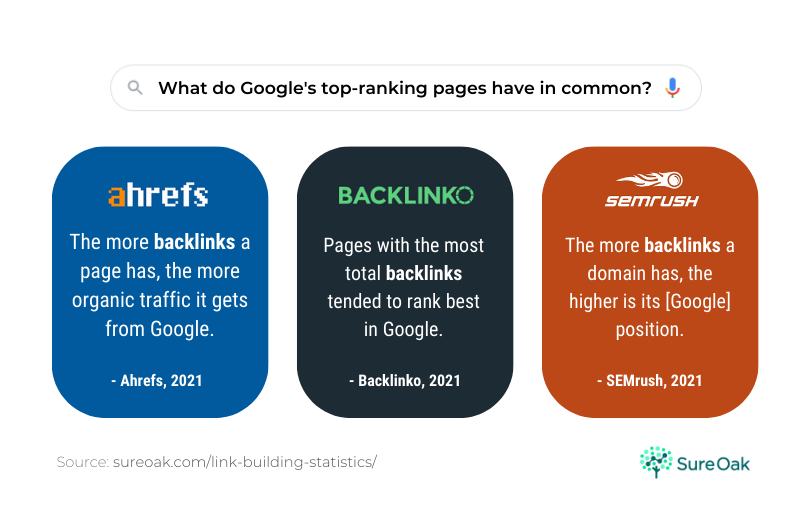
However, few marketers feel well-equipped to navigate, and quantify the ROI of, link building.
To help you achieve higher search rankings, we created this list of up-to-date backlink statistics for 2024.
Click to jump to a category:
- The Value of Link Building
- Link Building Challenges
- The Cost of Link Building
- Link Building Tactics
- Scaling Your Link Building Efforts
- Internal Linking Statistics
- Local Business Link Building Statistics
- How to Tackle Link Building in 2024
- Citations
13 Statistics to Prove the Value of Link Building
Good links are like “votes” for your website. Google uses them to determine your reputation on the web which, in turn, influences your search rankings.
The following statistics show that, even in 2024, link building is an effective tactic to improve SEO and brand awareness:
- 85% of SEO experts believe link building has a big impact on brand authority.²
- 69% of marketers say link building has delivered positive results for their business.³
And according to most SEO professionals, link building won’t be going anywhere:
- 59% of SEO experts believe backlinks will have a larger impact on Google rankings in the next few years, while 34% believe they will have the same impact.²
- 94% of marketers believe links will impact Google rankings in five years.³
- 73% of marketers believe links will impact Google rankings in ten years.³
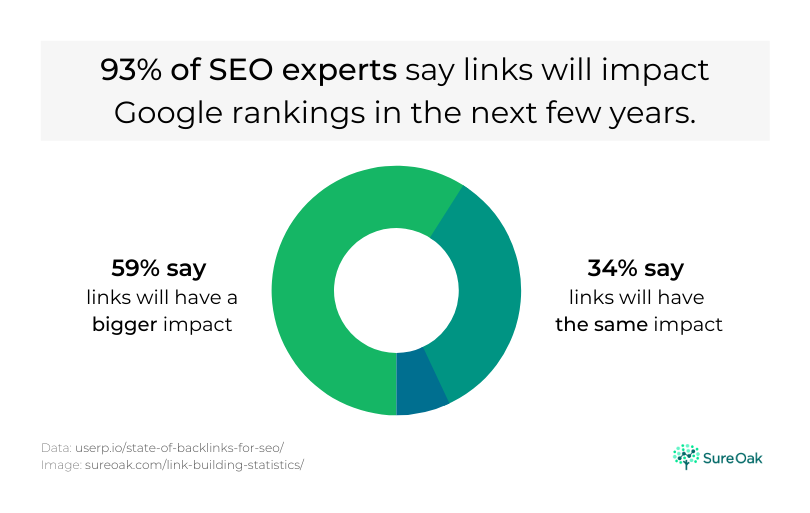
Some SEO pros are making bold claims about link building:
- 47.5% of SEO experts believe that backlinks are just as important as content.²
- 40% of SEO experts say that backlinks are their #1 priority.²
- 10% of SEO professionals say that link building is the most valuable SEO tactic.¹
And interest in link building appears to be higher than ever before:
- 59% of marketers report an increased demand for link building in the past year.³
- According to Google Trends, interest in link building reached an all-time high in October 2021.¹³
Professionals in some industries find it easier to acquire backlinks:
- According to a survey of SEO experts, the three easiest verticals for link building are Leisure/Tourism, Creative arts/design, and Hospitality.³
But a majority of SEO professionals say it’s about having better links–not just more.
- 56.2% of SEO experts believe that link quantity and quality have the biggest impact on rankings and authority.²
This last statistic has some significant implications. John Mueller states that:
“Because you could go off and create millions of links across millions of websites if you wanted to, and we could just ignore them all…Or there could be one really good link from one website out there that is, for us, a really important sign that we should treat this website as something that is relevant because it has that one link.“
While competing websites might have more links than you, it is still possible to outrank them by building better links.
Likewise, websites with a towering list of backlinks might not be as safe as they originally thought. A competitor focused on quality links is a credible threat to any business.
9 Statistics to Highlight Link Building Challenges
While marketers understand the value of backlinks more than ever, earning backlinks has become more challenging than ever.
The following statistics show that backlinks don’t come easy in 2024:
- 94% of published web pages have zero backlinks.⁶
- 2.2% of published web pages have more than 1 backlink.⁶
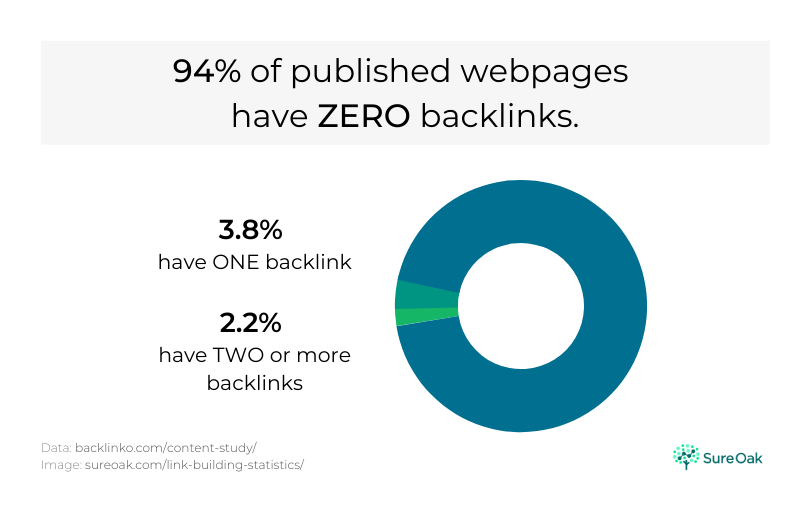
And according to many marketers, link building is only getting harder:
- 70% of marketers don’t offer guarantee when it comes to the volume of links they build, or metrics associated with links.³
- 20% of SEO professionals believe link building is becoming less effective for their brand.¹²
If you’re struggling to earn backlinks, you’re not alone:
- In the past year, 29% of marketers say they created a link building campaign that failed to generate a single backlink.³
- 40% of marketers say that generating backlinks is their biggest struggle.³
Earning links is especially difficult in certain industries:\
- According to SEO experts, the three hardest verticals for link building are Healthcare, Accountancy, and Law.³
But perhaps the greatest challenge is outranking Google’s top result:
- On average, Google’s #1 result has 3.8x more backlinks than positions #2-#10.⁴
- #1 ranking pages tend to attract new backlinks at a pace of 5% to 14.5% per month.⁵
Many high-volume keywords are dominated by competitors with hundreds–if not thousands–of backlinks. To make matters worse, these top-ranking pages tend to accumulate links passively as a result of their high rankings.
While these statistics might discourage you (and rightfully so), they show that link building is a valuable investment which will continue to pay dividends over time. In other words, if you can use links to compete for keywords, you should.
11 Statistics to Show the Cost of Link Building
How much does link building cost? The answer to this question depends on a number of factors, but most marketers are building links on a reasonable budget.
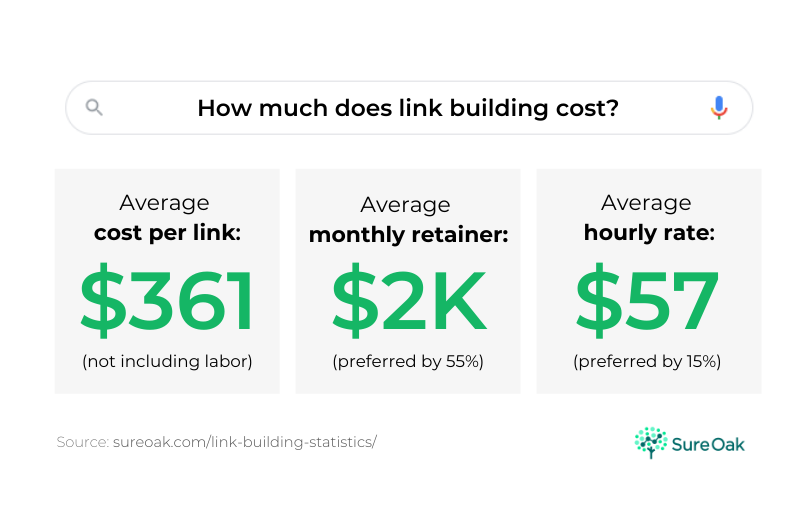
These statistics show that most marketers are earning links on a lean budget:
- 80% of marketers dedicate less than 50% of their budget to link building.³
- 21.33% of SEO professionals spend $2500 or less on their monthly link building budgets.¹
- 62.67% of SEO professionals spend less than $1000 per month on link building.¹
However, link building budgets are expected to increase in the near future:
- 48% SEOs report having a reduced link building budget as a result of the COVID-19 pandemic.¹
- 48% of marketers expect their link building budgets to increase in the next year.³
If you opt for private link purchases, they tend to be pricey:
But most link builders charge for their services on a monthly retainer:
- 45% of marketers charge for link building on a retainer fee.³
- Link building professionals charge an average monthly retainer of $2000.⁷
Some link builders prefer to charge by the hour:
- 20% of marketers charge an hourly rate for link building.³
- The average rate for a link builder is $57 per hour.⁷
It is important to note that these numbers reflect averages, and your results will likely vary.
Factors like your industry, your brand requirements, and your strategy will have a considerable impact on the cost of link building.
Oftentimes, the most cost-effective links are earned by leveraging relationships with industry connections. This is why many businesses trust a link building agency to make the most of their budget.
25 Statistics to Explore the Best Link Building Tactics
Strategists from Google and Bing have said that marketers shouldn’t try to earn new backlinks. If we create amazing content, the theory is that backlinks will come naturally.
While many marketers are producing link-worthy content, the data shows that brands can’t afford to wait for quality backlinks. That’s why a majority of marketers are using outreach-based strategies to build links.
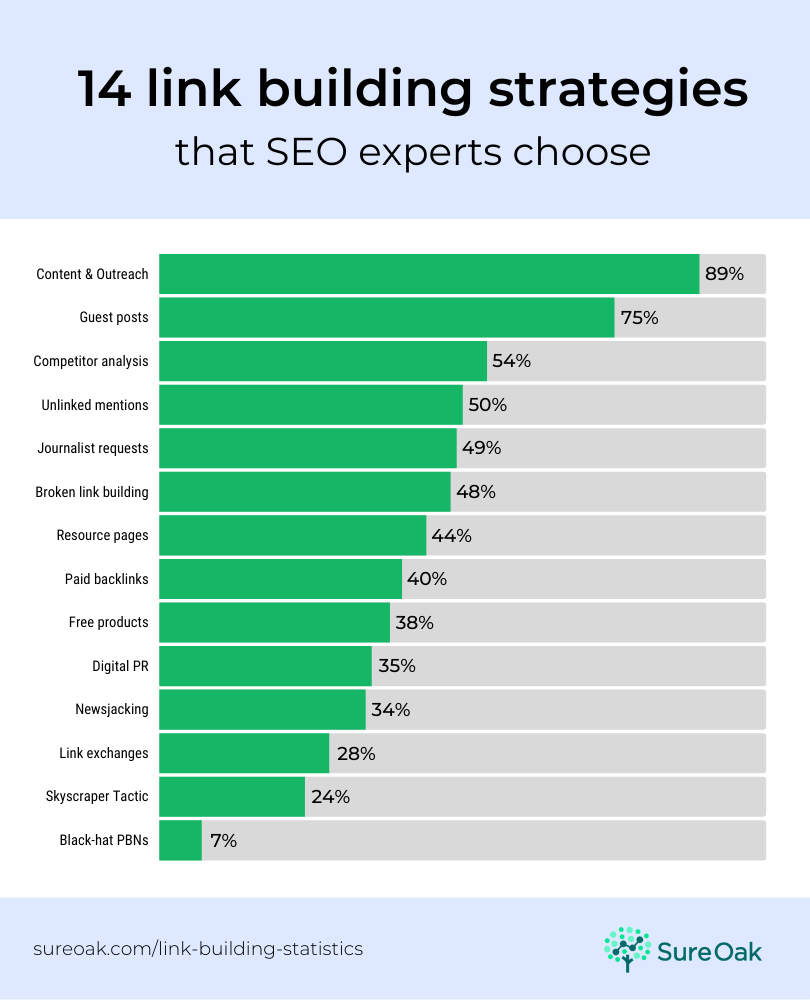
Research shows that most marketers use simple–yet effective–backlink strategies:
- 86% of marketers create content with the specific goal of generating links.³
- 75.33% of SEO professionals write guest posts to earn backlinks.¹
And many marketers opt for intermediate tactics:
- 54% of marketers track and replicate their competitors’ backlinks.³
- 37% of marketers target unlinked brand mentions for low-hanging backlinks.³
- 42% of marketers uses HARO to earn backlinks.³
- 48% of SEO professionals use the broken link building method.¹
- 56% of SEO experts recommend resource link building.¹⁰
Some marketers are dabbling in high-risk, high-reward strategies:
- 36% of SEO professionals use digital PR techniques to earn backlinks.¹
- 32% of marketers use newsjacking techniques to earn backlinks.³
- 18% of marketers use the ‘Skyscraper Technique’ to earn backlinks.³
While others are orchestrating link exchanges:
- 38.67% of SEO professionals perform link exchanges with other websites.¹
- 73.6% of high-traffic domains have reciprocal links.¹¹
Research shows that many marketers are still participating in manipulative link schemes:
- 69% of marketers say buying links can positively impact rankings.³
- 52.67% of SEO professionals arrange paid backlinks.¹
- 10% of eCommerce SEO specialists give products away in exchange for backlinks.³
- 7% of link builders use private blog networks (PBNs) for black-hat links.³
You might be surprised to learn that many SEO professionals are engaged in black-hat tactics that violate Google’s guidelines (such as paid links, PBNS, etc.) While these tactics are effective to some degree, the results are not sustainable. Google’s machine learning algorithms will eventually catch tactics that try to “cheat” the ranking system, and that’s why we don’t recommend them.
If you’d like to know more about white-hat link building, check out our list of 10 link building tactics we recommend in 2024.
9 Statistics About Guest Posting
Guest posting has been a prevalent link building tactic for over 10 years. While some SEO authorities have declared it a “dead” tactic, recent data says otherwise.
The following statistics show that guest posting is still popular in 2024:
- 75.33% of SEO experts write guest posts to generate backlinks.¹
- 47% of SEO experts use guest posts as a link building strategy.³
Most bloggers welcome the extra content:
- 73.30% of bloggers publish guest posts on their website.²²
- 97.5% of editors will increase or maintain the amount of guest content they publish in 2023.²⁴
- 52% of bloggers struggle to find time to create and promote content.²¹
A majority of bloggers don’t charge contribution fees:
- 35% of bloggers do not charge to publish guest posts.⁸
When there is a fee, it tends to be cheaper than the average link placement ($361):
- The average cost to publish a paid guest post is $77.80.⁹
Most professionals stress the importance of topical focus:
- 58% of SEO experts believe relevance is the most important element of a guest post.²³
While keyword-rich anchor text is becoming less of a priority:
- 38% of SEO experts report exact-match anchors becoming less effective for their brand.¹²
According to most marketers, guest posting is still one of the most effective ways to develop contextual backlinks. However, it is also clear that the guest posting strategy has evolved in recent years. To get tangible SEO results, it is essential that your guest contributions are relevant to your target audience.
33 Statistics to Scale Your Link Building Efforts
With Google’s continued reliance on backlinks as a ranking signal, knowing how to scale your link building efforts is essential to your long-term success.
Perhaps the simplest way to improve your link building strategy is to choose a trusted link building partner.
A majority of marketers hire experts to help with link building:
- 60% of marketers prefer to outsource link building to an agency or freelancer.²
While most expert link builders set goals, few offer a guarantee:
- 53% of marketers try to build a certain number of links each month.³
- 30% of marketers offer a guarantee for their link building services.³
This is not 100% necessary, but many experts also recommend SEO tools to help with link building tasks.
Link builders use a variety of tools, but two of them are especially popular:
- 76% of SEO professionals use Ahrefs for link building purposes.¹
- 86.67% of SEO professionals use SEMrush for link building purposes.¹
Many marketers also use Google’s free tools to help with link building:
- 65% of SEO professionals use Google Sheets for link building purposes.³⁰
- 51% of SEO professionals disavow links through Google Search Console.³
In any case, the key to scalable link building lies in proper measurement, efficient outreach, and evergreen assets that generate quality links. In the following sections, we will shed more light on these three crucial factors.
Creating Linkable Content
The best way to generate more backlinks is by creating content that is genuinely deserving of links. This not only increases the effectiveness of your outreach, but it can also help you acquire passive links that you did not ask for.
Research shows that highly-linked content contains a lot of information:
- Articles of average length (900-1200 words) get 75% more backlinks than short posts (300-900 words).¹⁸
- 56% of marketers say long-form reports generate the most backlinks.³
In addition, how-to posts tend to act as effective link magnets:
- How-to posts attract 45% more backlinks than list-style articles..¹⁹
- How-to posts generate 183% more backlinks than infographics.¹⁹
Multimedia content also increases the likelihood of generating links:
- Articles with one image generate 50% more backlinks than articles with no images.¹⁸
- Posts with one list per 500 words attract 40% more backlinks than posts with no lists.²⁰
- Posts with one video attract 30% more backlinks than posts with no videos.²⁰
- 42% of marketers say interactive content generates the most backlinks.³
Performing Effective Link Outreach
Outreach tends to be the most time-consuming stage of a link building campaign. Nonetheless, it is still necessary to put your website on other people’s radars. The success of your campaign depends on efficient and effective outreach.
Acquiring links from outreach is far from impossible:
- 70% of bloggers regularly update their old content.²¹
However, getting a response from bloggers is a difficult task:
- Only 8.5% of all outreach emails receive a response.²⁵
Multiple contacts and follow-ups are highly recommended:
- Outreach campaigns with a single follow-up email generate 65.8% more replies.²⁵
- Outreach emails sent to several contacts generate 93% more responses.²⁵
- Outreach campaigns with multiple follow-ups and multiple contacts receive 160% more responses.²⁵
And personalized outreach is also worth considering:
- Outreach emails with personalized subject lines generate 30.5% more responses.²⁵
- Outreach emails with a personalized message generate 32.7% more responses.²⁵
Most professionals only spend a few weeks on outreach before moving on:
- 36% of marketers spend 3-4 weeks on a typical outreach campaign.³
Measuring and Reporting Link Building Results
When it comes to measuring and reporting link building outcomes, many marketers don’t know where to start. How do you know when your efforts are successful, and how can you prove it?
According to survey data, seeing the results of your work could take up to 6 months:
- 30% of marketers say it takes less than 6 months to see link building results.³
- 49% of marketers say it takes less than 3 months to see link building results.³
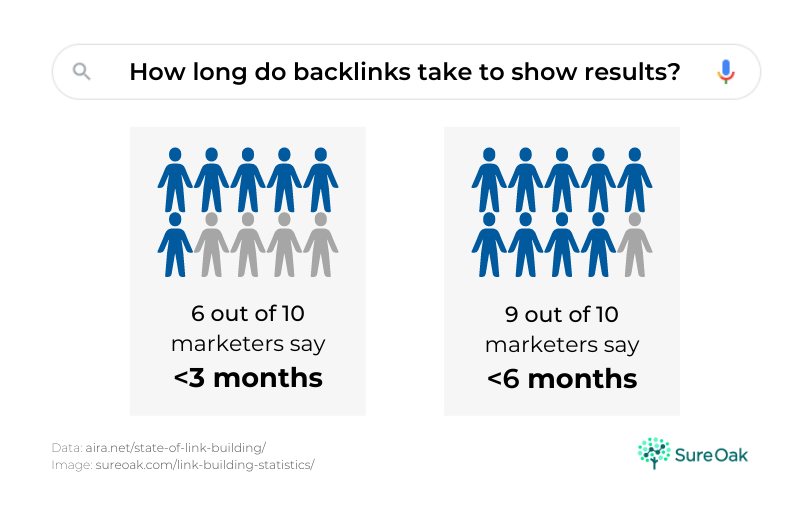
Many marketers are tracking every citation–not just “dofollow” links:
- 80% of marketers believe “unlinked” brand mentions can influence organic rankings.³
- 62% of marketers report on “nofollow” links as a significant metric.³
- 52% of marketers report syndicated links as part of their overall link target.³
Third-party metrics are a favorite choice for measuring link authority:
- 67% of marketers use Ahrefs domain rating to measure the quality of a link.³
- 42% of marketers use Moz domain authority to measure the quality of a link.³
While rankings and referring domains are the two most popular KPIs:
- 53% of marketers use rankings as their primary link building KPI.³
- 35% of marketers use referring domains as their primary link building KPI.³
Only a few marketers can tie their links to conversions:
- 13% of marketers use conversions as their primary link building KPI.³
6 Internal Linking Statistics
Internal links go from one page to another on the same website. They not only help users navigate your website, but they also increase your website’s Google rankings.
For some marketers, internal links are extremely important:
- 8% of SEO professionals say internal links are the most important ranking factor.²⁹
- 42% of marketers spend as much time on internal links as they do external links.²⁶
And most marketers have guidelines for internal linking:
- 51% of marketers say blog posts should include at least 2 internal links.²⁶
However, most websites don’t adhere to this advice:
While many marketers are building external links to boost their authority, few marketers are using internal links to distribute that authority to other pages on their website.
Forming and implementing an internal link structure could have a considerable impact on your Google rankings. Since it requires no outreach, it’s also one of the simplest ways to increase the impact of your link building efforts.
You can learn more about this tactic in our guide to internal linking.
8 Local Business Link Building Statistics
When it comes to link building, few local businesses understand its importance, and even fewer businesses know how to start.
Nonetheless, link building will continue to be an important local ranking factor, and it’s not nearly as complicated as it may seem.
While they might use different backlink strategies, all local marketers agree:
- 100% of local marketers say link building is an effective way to boost local search rankings.¹⁴
But that doesn’t necessarily mean they all build links:
- 50% of local marketers offer link building as a service.¹⁷
Link building is getting harder for local marketers:
- 47% of local marketers say link building has become more difficult in the past year.¹⁴
- 22% of local marketers say their link building budget has been reduced due to COVID-19.¹⁵
These challenges deter local businesses from investing:
- 21% of small businesses are investing in link building.¹⁶
- 18% of local marketers wish their clients were devoting more resources to link building.¹⁵
However, most local marketers do have a link building strategy:
- 71% of local marketers have a link building strategy in place.¹⁵
Content + outreach is a favorite link building tactic among local marketers:
- 38% of local marketers say content development is the most effective tactic to earn backlinks.¹⁵
Often, local marketers perform link building as part of their general SEO strategy. This means that some local businesses might be investing in backlinks without knowing about it.
That being said, it is important to know what steps your local business is taking to ensure high Google rankings. If you aren’t investing in link building, it may be time to develop a strategy that fits your needs.
How to Tackle Link Building in 2024
Despite all the growth and change in the SEO industry, one truth still reigns supreme:
Link building is essential for high rankings and search traffic.
Most SEO research shows that the links pointing to your content are just as important as the content itself. While search algorithms will operate differently in the future, it’s likely that they will always rely on backlinks to some degree.
On the other hand, the dynamics of link building are constantly evolving. Link building experts have encountered new challenges in the past few years, and we expect this trend to continue.
Whether you’re currently building links, or if you’re just interested in doing so, it is important to stay on top of new trends, technologies, and practices in the link building world. While there are no shortcuts to sustainable backlinks, you can preserve resources by implementing a custom link building strategy that fits with your business goals.
If your company does not have the bandwidth to undertake a link building strategy, you should consider partnering with a link building agency to help with the process.
A complete link building strategy requires several considerations, including:
- Competitor research,
- Content creation,
- Prospecting,
- Outreach, and
- Measurement.
Once you understand these fundamental skills, you will realize that there is no secret to building quality links–just time, resources, and willingness to learn.
Citations
- LinkDoctor, 2023. Link Building Survey 2023 Edition
- uSERP, 2024. The State of Backlinks for SEO in 2024.
- Aira, 2022. The State of Link Building Report 2022.
- Backlinko, 2023. We Analyzed 11.8 Million Google Search Results. Here’s What We Learned About SEO.
- Ahrefs, 2018. How Many New Backlinks Do Top-ranking Pages Get Over Time?
- Backlinko, 2019. We Analyzed 912 Million Blog Posts. Here’s What We Learned About Content Marketing.
- North Star Inbound, 2020. State of SEO Survey.
- SociallyInfused Media, 2023. What’s the Cost of Buying Links in 2023? We Contacted 1,950 Blogs to Uncover the Truth.
- Ahrefs, 2022. Should You Buy Backlinks in 2023? It Depends
- Backlinko, 2022. Resource Page Link Building
- Ahrefs, 2020. Reciprocal Links: Will They Hurt Your SEO? (A Study by Ahrefs)
- Zazzle Media, 2019. The State of SEO 2019.
- Google Trends, 2021. Link Building – Explore.
- BrightLocal, 2019. Expert Local Business Link Building Survey.
- Moz, 2020. The State of Local SEO Industry Report 2020.
- The Manifest, 2021. Small Business SEO Statistics 2021.
- BrightLocal, 2023. Local Search Industry Survey 2023.
- Semrush, 2021. The Anatomy of Top Performing Articles.
- Fractl, 2020. What The Most Highly Linked-To Pages Tell Us About Successful Content.
- Semrush, 2023. The State of Content Marketing 2023.
- Orbit Media Studios, 2023. 2023 Blogging Statistics.
- First Site Guide, 2023. The State of The Blogging Industry in 2020.
- Databox, 2021. Link Building 101: The Ultimate Guide to Building Free Backlinks and Outranking Your Competitors.
- Influence&Co., 2023. 2023 State Of Contributed Content Report.
- Backlinko, 2019. We Analyzed 12 Million Outreach Emails. Here’s What We Learned.
- Databox, 2021. How to Use Internal Links to Boost SEO and the User Experience.
- Semrush, 2024. SEO Mistakes: Common SEO Issues & How to Fix Them.
- Semrush, 2024. 11 Common Internal Linking Mistakes & How to Fix Them.
- Search Engine Journal, 2024. The State of SEO 2024.
- LinkDoctor, 2021. Link Building Survey 2020, COVID-19 Edition: Here’s What We Found

